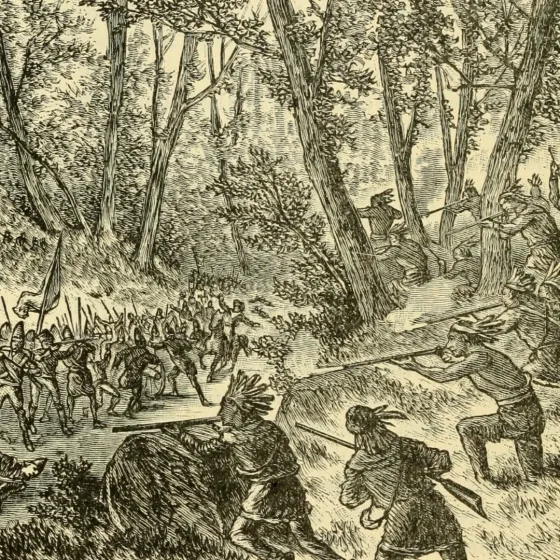
Many Native Americans played an important role in the American Revolution. Here are 10 facts that outline some of the contributions of the Native Americans in the 18th century War for American Independence.
Fact #1: The American Revolution split the Iroquois Confederacy of Native Americans, with the Oneidas and Tuscarora siding with the Americans and the other five tribes aligning themselves with the British.
The Oneida occupied land in central New York and were closest geographically to the eastern seaboard. They became the staunchest allies of the Patriot cause among the Iroquois Confederacy. The Tuscarora who were accepted into the six nations with the help of the Oneida had factions that supported both sides in the war and shared reservation land after the conflict with Oneidas before getting their own allotted spot.
Fact #2: Catawba Native Americans assisted militia and Patriot partisans in actions in North and South Carolina.
Although the Catawbas sided with the British during the French and Indian War, on the eve of the American Revolution, a reservation in South Carolina was formed for them. With the British presence in the area during 1780-1781, the Catawba saw many of their homesteads torched. This propelled them more into the American camp, where they served at places like Guilford Courthouse in March 1781, and with the famed militia commander General Thomas Sumter in South Carolina.
Fact #3: Stockbridge Native Americans assisted in the defining American victory at Saratoga and the last major engagement in the Northern Theater, at Monmouth in June 1778.
The first of many Native American tribes to side with the Americans, the Mohican, Wappinger, and Munsee Native Americans, all in the general area of Stockbridge, Massachusetts, cast their lot with the revolutionaries. In 1774, meeting in Stockbridge, the tribe issued the following statement:
“Wherever your armies go, there we will go; you shall always find us by your side; and if providence calls us to sacrifice our Lives in the field of battle, we will fall where you fall, and lay our bones by yours. Nor shall peace ever be made between our nation and the Red-Coats until our brothers -the white people- lead the way.”
Fact #4: Polly Cooper, an Oneida, traveled with male warriors to Valley Forge during the Continental Army winter encampment.
While there, she showed the Army how to make soup from corn husks, which helped ease some of the hunger of the soldiery. This trek, through winter, covered hundreds of miles from New York to Pennsylvania and was part of the relief mission. Her companions, including her husband, brought hundreds of bushels of white corn to feed the Continental army. After the war, she refused any payment except a token of appreciation from Martha Washington.

Fact #5: At the Battle of Barren Hill, fought on May 20, 1778, Oneida warriors acted as scouts for the American forces.
Serving alongside Daniel Morgan’s Virginia riflemen to scout and fight as skirmishers, the Oneidas provided early warning of the advancing British forces. This allowed the Marquis de Lafayette’s force to execute a fighting withdrawal in good order. Six Oneidas fell in the combat and are honored with a plaque in the St. Peter’s Lutheran Church in Lafayette Hill, Pennsylvania.
Fact #6: Guy Johnson, British Superintendent of Indian Affairs, and Joseph Brant were crucial to influencing Native Americans in the north to be pro-British.
Guy Johnson took over for his uncle as Superintendent of Indian Affairs in 1774 and was instrumental in rallying the majority of the tribes of the Iroquois Confederacy to the British cause. Joseph Brant rose to prominence as a Mohawk military and political leader and waged a partisan war in New York for the British.
Fact #7: Massacre at Gnadenhutten.
On March 8, 1782, peaceful Delaware or Lenape Native Americans were massacred at the Moravian missionary village at Gnadenhutten by Pennsylvania militiamen. Altogether, 96 Native Americans were killed in what future United States President Theodore Roosevelt called “a stain on frontier character that the lapse of time cannot wash away.”
Fact #8: Native American Civil War.
Much like the overall war itself between former British colonists and Mother Country, the American Revolution tore Native American tribes apart as well. At the Battle of Oriskany in 1777, for example, tribes of the Six Nations fought on opposing sides. The Oneida with the New York militia and Senecas and Mohawks with their British allies. In the Ohio Valley country, Shawnees and Delaware Indians were courted by both the British and American military commanders. Within the Cherokee Nation, younger warriors defied the directives of elder tribal leaders and raided frontier settlements.

Fact #9: Cherokee Tribe and the American Revolution.
One of the largest Native American tribes in the south, the Cherokees were mostly aligned with the British, seeing the colonials as encroaching on their land. Andrew Pickens, a South Carolina militia commander, led a devastating raid against the Cherokee in the latter stages of the war which forced the tribe to cede land in Georgia.
Fact #10: Conotocarious.
The name Conotocarious was given to George Washington, which showed the communication and memory of the various eastern Native American tribes. This name, meaning “town destroyer” was first given to George Washington’s grandfather in the 17th century, but his grandson had the name bestowed upon him with his first contact with Native Americans in 1753. The name stayed with Washington through the American Revolution and into his presidency.
Related Battles
465
28
330
1,135





